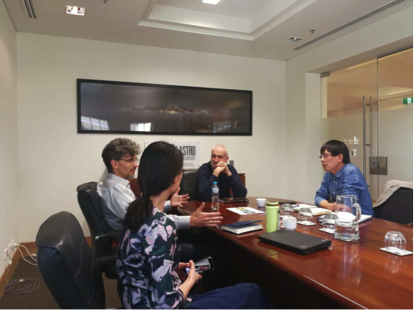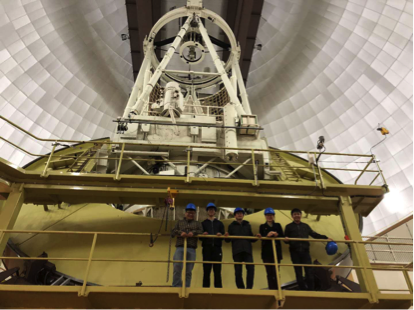中国西南天文研究所刘晓为教授一行访问澳大利亚
A delegation led by Xiaowei Liu visited Australia
为做好天文学一流学科重点项目1.6米多通道测光巡天望远镜研制工作,3月17日至3月24日,中国西南天文研究所刘晓为教授一行5人访问了澳大利亚国立大学天文与天体物理研究院。
访问期间,刘晓为教授一行与澳大利亚国立大学天文与天体物理研究院院长Matthew Colless教授、澳大利亚国立大学赛丁泉天文台台长Chris Lidman博士、澳大利亚国立天文台SkyMapper巡天项目总负责人Christian Wolf博士、Skymapper项目工程负责人Christopher Onken博士以及相关科研工程人员就1.35米SkyMapper望远镜建设、SkyMapper南天数字巡天、相关数据处理及后续科学研究等方面展开了深入的探讨与交流。并就未来云南大学中国西南天文研究所与澳大利亚国立大学天文与天体物理研究院的合作达成了初步共识。
访问期间,陈丙秋副教授、李正阳副研究员与黄样副教授分别做了“多通道测光巡天望远镜-Mephisto”“Mephisto技术方案设计”和“LAMOST银河系巡天科学成果”口头报告,向澳大利亚国立大学的师生们介绍了云南大学“双一流”重点建设项目多通道测光巡天望远镜的科学与技术相关内容,以及云南大学中国西南天文研究所近场宇宙学团组近年来基于国家大科学装置郭守敬望远镜的科学研究成果。
刘晓为一行实地考察了澳大利亚赛丁泉天文台1.35米SkyMapper望远镜、3.9米英澳望远镜、1.24米英国施密特望远镜、2.3米先进工艺望远镜、1.6米韩国微引力透镜望远镜网等望远镜设备。与驻站工程师、科学家进行了深入交流,重点讨论1.35米SkyMapper望远镜的光学系统、焦面装置与制冷系统以及圆顶设计等核心技术。
本次访问取得了较大成果,团队成员详细了解了澳大利亚1.35米SkyMapper望远镜的建设与运行相关的经验与教训;对许多技术细节,如望远镜制冷系统的振动问题等有了深刻的认识;并为双方的深度合作打下了良好的基础。
澳大利亚国立大学天文与天体物理研究院拥有斯特朗洛山天文台与赛丁泉天文台两个天文台,是澳大利亚最主要的光学与红外天文实测与研究基地。在恒星物理、银河系与河外星系研究等方面处于国际领先地位。澳大利亚1.35米SkyMapper望远镜位于赛丁泉天文台,是由诺贝尔物理学奖得主Brian Schmidt教授主导建造的一台大视场光学测光巡天望远镜。该项目于2003年启动,2009年望远镜建成,2014年开始进行SkyMapper南天数字巡天,巡天的第一版数据于2017年底发布。云南大学“双一流”重点建设项目多通道测光望远镜Mephisto的口径与巡天效率优于SkyMapper望远镜,且具有三通道可以同时拍摄天体的三个波段的图像,获取高质量的颜色信息。Mephisto的光学系统、焦面装置以及滤光片系统与SkyMapper十分类似,因此SkyMapper对Mephisto有很强的借鉴作用。

刘晓为教授、袁祥岩研究员与澳大利亚国立大学天文与天体物理研究院院长Matthew Colless教授、澳大利亚国立天文台SkyMapper巡天项目总负责人Christian Wolf博士交流讨论。

团组成员在3.9米英澳望远镜合影。

A delegation led by Prof. Xiaowei Liu, the director of South-Western Institute For Astronomy Research (SWIFAR) visited Australia from March 17th to 24th, 2018, at the invitation of Professor Matthew Colless, the director of Research School of Astronomy and Astrophysics (RSAA) of Australian National University.
During the visit, the delegation had intensive and in-depth discussions with a group of Australian scientists and engineers, including Prof. Matthew Colless, the director of RSAA, Dr. Chris Lidman, the director of the Siding Spring Observatory, Dr. Christian Wolf, the leader of the SkyMapper Southern Survey, Dr. Christopher Onken, the SkyMapper operation manager, and a few other scientists and engineers. The SkyMapper team introduced to the delegation the design and construction of the 1.35m SkyMapper Telescope, the conduction of the SkyMapper Southern Survey, the data processing and follow-up scientific studies. Dr. Bingqiu Chen from SWIFAR gave a general introduction and the driving science cases for the Multi-channel photometric survey telescope – Mephisto. Dr. Zhengyang Li from Nanjing Institute of Astronomical Optics & Technology presented the Mephisto optical design. Dr. Yang Huang from SWIFAR introduced the LAMOST Galactic Spectroscopic Surveys and the associated research. The promising prospects of scientific collaborations between SWIFAR and RSAA were also discussed extensively.
The delegation also paid site visits to the SkyMapper Telescope, the 3.9m Anglo-Australian Telescope, the 1.24m UK Schmidt Telescope, the 2.3m Advanced Technology Telescope, and the 1.6m Korea Microlensing Telescope Network. They discussed with the engineers and scientists from the Siding Spring Observatory about the technical details of the SkyMapper Telescope, such as the optical system, focal plane devices including the cooling systems, and the dome design.
The fruitful visit is very beneficial for the development of the Mephisto project led by SWIFAR, whose design has many similarities with that of the SkyMapper telescope. The delegation members have learned the experiences and the lessons on the construction and operation of the SkyMapper telescope, and gained deep understandings about many technical details, such as the vibration problems of the cooling system of the camera. With common interests in scientific research and in instrumental development, we see a bright future for the collaborations between SWIFAR and RSAA.
